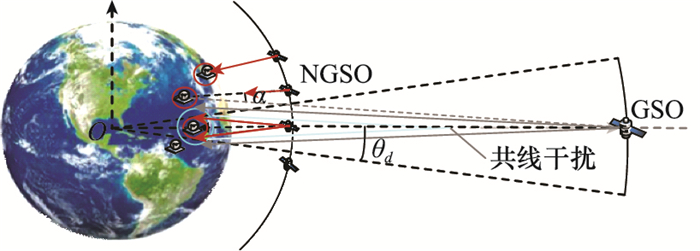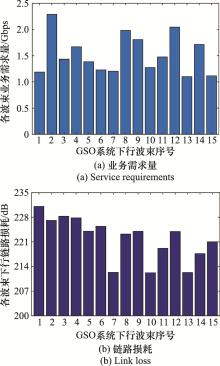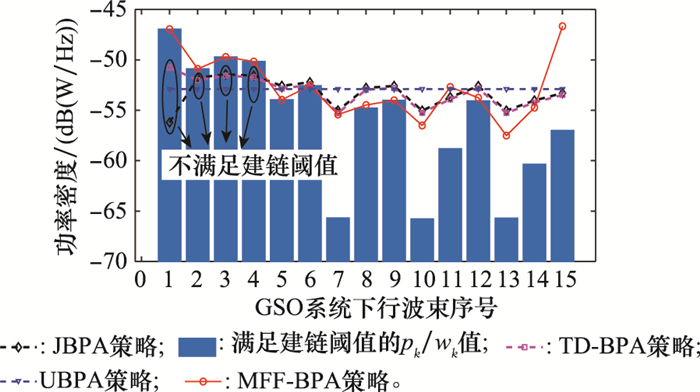Systems Engineering and Electronics ›› 2022, Vol. 44 ›› Issue (4): 1382-1392.doi: 10.12305/j.issn.1001-506X.2022.04.37
• Communications and Networks • Previous Articles Next Articles
Research on NGSO-GSO frequency interference calculation method fused with power allocation strategy
Suhui DONG1,2, Ji PAN3, Xiujuan YAO1,*, Xiang GAO1, Yi YAN1, Jia ZHI1
- 1. National Space Science Center, Chinese Academy of Sciences, Beijing 100190, China
2. University of Chinese Academy of Sciences, Beijing 100049, China
3. State Radio Monitoring Center, Beijing 100037, China
-
Received:2021-04-22Online:2022-04-01Published:2022-04-01 -
Contact:Xiujuan YAO
CLC Number:
Cite this article
Suhui DONG, Ji PAN, Xiujuan YAO, Xiang GAO, Yi YAN, Jia ZHI. Research on NGSO-GSO frequency interference calculation method fused with power allocation strategy[J]. Systems Engineering and Electronics, 2022, 44(4): 1382-1392.
share this article
Table 1
Orbit, beam and air interface parameters of GSO systems for uplink and downlink"
| 链路参数 | 下行链路 | 上行链路 |
| GSO卫星经度/°E | 118 | 118, 101.5 |
| 卫星数量 | 1 | 2 |
| 中心频率/GHz | 18.45 | 27.75 |
| 每发射机总带宽/MHz | 1 500 | 1 000 |
| 每波束最大带宽/MHz | 1 500 | - |
| 每波束最小带宽/MHz | 0 | - |
| 每波束平均带宽/MHz | 100 | 500 |
| 波束数量 | 15 | 2 |
| 接收机接收天线峰值增益/dBi | 51.8 | 39 |
| 每发射机总功率/dBW | 38.86 | 42.7 |
| 发射机发射天线峰值增益/dBi | 39 | 55.3 |
| 极化方式 | M | M |
| 调制方式 | BPSK | BPSK |
| 接收机天线噪声温度/K | 110 | 580 |
Table 2
Beam and air interface parameters of NGSO systems for uplink and downlink"
| 链路参数 | 下行链路 | 上行链路 |
| 卫星数量 | 18×40 | 18×40 |
| 中心频率/GHz | 18.50 | 27.55 |
| 每发射机总带宽/MHz | 1 600 | 100 |
| 每波束最大带宽/MHz | 1 600 | 100 |
| 每波束最小带宽/MHz | 0 | - |
| 每波束平均带宽/MHz | 100 | - |
| 波束数量 | 16 | - |
| 接收机接收天线峰值增益/dBi | 33.6 | 31.2 |
| 每发射机总功率/dBW | 30.94 | 18.70 |
| 发射机发射天线峰值增益/dBi | 27.6 | 60.8 |
| 极化方式 | M | M |
| 调制方式 | BPSK | BPSK |
| 接收机天线噪声温度/K | 120 | 600 |
Table 3
Objective function values calculated by different allocation strategies of the GSO downlink beam"
| 分配策略 | 满足[C/N]th的波束数量 | |
| UBPA | 1.68×1019 | 10 |
| JBPA | 1.46×1019 | 11 |
| TD-BPA | 1.51×1019 | 11 |
| MFF-BPA | 1.57×1019 | 15 |
Table 5
Comparison results of the I/N exceeding the limit of -12.2 dB"
| 链路类型 | GSO系统分配策略 | NGSO系统分配策略 | I/N超限百分比/% |
| 下行 | UBPA | UBPA | 6.99 |
| 下行 | UBPA | JBPA | 7.30 |
| 下行 | UBPA | ILF-BPA | 5.86 |
| 下行 | JBPA | UBPA | 6.72 |
| 下行 | JBPA | JBPA | 7.26 |
| 下行 | JBPA | ILF-BPA | 5.95 |
| 下行 | MFF-BPA | UBPA | 6.75 |
| 下行 | MFF-BPA | JBPA | 4.73 |
| 下行 | MFF-BPA | ILF-BPA | 3.10 |
| 上行 | UBPA | - | 7.97 |
| 上行 | JBPA | - | 8.96 |
| 上行 | ILF-BPA | - | 8.48 |
| 1 | RADTKE J , KEBSCHULL C , STOLL E . Interactions of the space debris environment with mega constellations—using the example of the OneWeb constellation[J]. Acta Astronautica, 2017, 131 (1): 55- 68. |
| 2 | PELTON J N , MADRY S , CAMACHO-LARN S . Handbook of satellite applications[M]. 2nd Ed. New York: Springer Press, 2017. |
| 3 |
HANSON W A . Satellite internet in the mobile age[J]. New Space, 2016, 4 (3): 138- 152.
doi: 10.1089/space.2016.0019 |
| 4 |
SHARMA S K , CHATZINOTAS S , OTTERSTEN B . In-line interference mitigation techniques for spectral coexistence of GEO and NGEO satellites[J]. International Journal of Satellite Communications and Networking, 2016, 34 (1): 11- 39.
doi: 10.1002/sat.1090 |
| 5 | 张泓湜, 蒋伯峰. 基于空间隔离的低轨卫星系统频谱共享方法[J]. 北京航空航天大学学报, 2018, 44 (9): 1909- 1917. |
| ZHANG H S , JIANG B F . Spatial isolation methodology for spectral coexistence in LEO satellite systems[J]. Journal of Beijing University of Aeronautics and Astronautics, 2018, 44 (9): 1909- 1917. | |
| 6 | 靳瑾, 李娅强, 匡麟玲, 等. 全球动态场景下非静止轨道通信星座干扰发生概率和系统可用性[J]. 清华大学学报(自然科学版), 2018, 58 (9): 833- 840. |
| JIN J , LI Y Q , KUANG L L , et al. Occurrence probability of co-frequency interference and system availability of non-geostationary satellite system in global dynamic scene[J]. Journal of Tsinghua University (Science and Technology), 2018, 58 (9): 833- 840. | |
| 7 | ITU-R S. 1325-3. Simulation methodologies for determining statistics of short-term interference between co-frequency, codirectional non-geostationary-satellite orbit fixed-satellite service systems in circular orbits and other non-geostationary fixed-satellite service systems in circular orbits or geostationary-satellite orbit fixed-satellite service networks[S]. Geneva: ITU, 2003. |
| 8 | ITU-R S. 1419-0. Interference mitigation techniques to facilitate coordination between non-geostationary-satellite orbit mobile-satellite service feeder links and geostationary-satellite orbit fixed-satellite service networks in the bands 19.3-19.7 GHz and 29.1-29.5 GHz[S]. Geneva: ITU, 1999. |
| 9 | ITU-R S. 1257-3. Analytical method to calculate short-term visibility and interference statistics for non-geostationary satellite orbit satellites as seen from a point on the earth's surface[S]. Geneva: ITU, 2002. |
| 10 | ITU-R S. 1503-3. Functional description to be used in developing software tools for determining conformity of non-geostationary-satellite orbit fixed-satellite service systems or networks with limits contained in Article 22 of the Radio Regulations[S]. Geneva: ITU, 2018. |
| 11 | WANG H W, WANG C, YUAN J, et al. Coexistence downlink interference analysis between LEO system and GEO system in Ka band[C]//Proc. of the IEEE/CIC International Confe-rence on Communications in China, 2018: 465-469. |
| 12 | SHARMA S K, CHATZINOTAS S, OTTERSTEN B. Cognitive radio techniques for satellite communication system[C]//Proc. of the IEEE 78th Vehicular Technology Conference, 2013: 1-5. |
| 13 |
POURMOGHADAS A , SHARMA S K , CHATZINOTAS S , et al. On the spectral coexistence of GSO and NGSO FSS systems: power control mechanisms and a methodology for inter-site distance determination[J]. International Journal of Satellite Communications and Networking, 2017, 35 (5): 443- 459.
doi: 10.1002/sat.1199 |
| 14 | LI R, GU P W L, HUA C Q. Optimal beam power control for co-existing multibeam GEO and LEO satellite system[C]//Proc. of the 11th International Conference on Wireless Communications and Signal Processing, 2019: 1-6. |
| 15 | 王闯, 胡婧, 李永强, 等. 空间信息网络中面向双卫星的频谱共享方法[J]. 航空学报, 2019, 40 (9): 322863. |
| WANG C , HU J , LI Y Q , et al. Spectrum sharing method for dual satellite in space information network[J]. Acta Aeronautica et Astronautica Sinica, 2019, 40 (9): 322863. | |
| 16 | 李广侠, 冯琦, 冯少栋. 多点波束宽带卫星系统波束间功率优化分配算法[J]. 解放军理工大学学报(自然科学版), 2013, 14 (1): 1- 6. |
| LI G X , FENG Q , FENG S D . Optimal inter-beam power allocation algorithm for multi-beam broadband satellite systems[J]. Journal of PLA University of Science and Technology (Natural Science Edition), 2013, 14 (1): 1- 6. | |
| 17 | 刘功亮, 顾学迈, 康文静, 等. 单播组播共存环境下的多波束卫星功率优化分配[J]. 吉林大学学报(工学版), 2008, 38 (4): 970- 975. |
| LIU G L , GU X M , KANG W J , et al. Power allocation scheme for multiple spotbeam satellite communication systems with coexisting unicast and multicast flows[J]. Journal of Jilin University (Engineering and Technology Edition), 2008, 38 (4): 970- 975. | |
| 18 | ITU-R P. 618-13. Propagation data and prediction methods required for the design of Earth-space telecommunication systems[S]. Geneva: ITU, 2017. |
| 19 | ITU. Coordination of the CHNNEWSAT-G1-118E satellite network in IFIC 2870[EB/OL]. [2021-04-01]. https://www.itu.int/online/sns/geo.sh?sat_type=G&ie=y&ntc_id=117520445&categ=C. |
| 20 | ITU. Coordination of the L5 satellite network in IFIC 2862[EB/OL]. [2021-04-01]. https://www.itu.int/online/sns/nongeo.sh?sat_type=N&ie=y&ntc_id=113520120&categ=C. |
| 21 |
史煜, 张邦宁, 郭道省, 等. 考虑波束间干扰的多波束卫星功率带宽联合分配算法[J]. 计算机工程, 2018, 44 (2): 103- 106. 103-106, 113
doi: 10.3969/j.issn.1000-3428.2018.02.018 |
|
SHI Y , ZHANG B N , GUO D X , et al. Joint power and bandwidth allocation algorithm with inter-beam interference for multi-beam satellite[J]. Computer Engineering, 2018, 44 (2): 103- 106. 103-106, 113
doi: 10.3969/j.issn.1000-3428.2018.02.018 |
|
| 22 |
CHOI J P , CHAN V W S . Optimum power and beam allocation based on traffic demands and channel conditions over satellite downlinks[J]. IEEE Trans.on Wireless Communications, 2005, 4 (6): 2983- 2993.
doi: 10.1109/TWC.2005.858365 |
| 23 | 贾录良, 刘爱军, 郭道省, 等. 多波束卫星通信功率分配算法与仿真分析[J]. 系统仿真学报, 2014, 26 (11): 2687- 2691. |
| JIA L L , LIU A J , GUO D X , et al. Optimal power allocation algorithm and simulation analysis for multi-spot-beam satellite[J]. Journal of System Simulation, 2014, 26 (11): 2687- 2691. | |
| 24 |
王蔚龙, 赵尚弘, 李勇军. 基于能量效率的分布式星群下行链路功率分配方法研究[J]. 电子学报, 2020, 48 (6): 1177- 1181.
doi: 10.3969/j.issn.0372-2112.2020.06.019 |
|
WANG W L , ZHAO S H , LI Y J . Power allocation in distri-buted satellite cluster downlink based on energy efficiency[J]. Acta Electronica Sinica, 2020, 48 (6): 1177- 1181.
doi: 10.3969/j.issn.0372-2112.2020.06.019 |
|
| 25 |
韩寒, 李颖, 董旭, 等. 卫星通信系统中功率与时隙资源联合分配算法[J]. 通信学报, 2014, 35 (10): 23- 30.
doi: 10.3969/j.issn.1000-436x.2014.10.004 |
|
HAN H , LI Y , DONG X , et al. Algorithm on joint optimization of power allocation and slot allocation in satellite communication systems[J]. Journal on Communications, 2014, 35 (10): 23- 30.
doi: 10.3969/j.issn.1000-436x.2014.10.004 |
|
| 26 | 尼俊红, 申振涛, 杨会峰. 蜂窝网络下基于max-min公平性的D2D功率分配[J]. 计算机应用, 2017, 37 (4): 945- 947. 945-947, 953 |
| NI J H , SHEN Z T , YANG H F . D2D power allocation based on max-min fairness underlying cellular systems[J]. Journal of Computer Applications, 2017, 37 (4): 945- 947. 945-947, 953 | |
| 27 |
ZUO J K , YANG L X . Energy efficient resource allocation for D2D multicast communications[J]. Journal of Central South University, 2019, 26 (11): 3034- 3044.
doi: 10.1007/s11771-019-4234-0 |
| 28 | DELPORTILLO I , CAMERON B G , CRAWLEY E F . A technical comparison of three low earth orbit satellite constellation systems to provide global broadband[J]. Acta Astronautica, 2019, (159): 123- 135. |
| 29 | ITU-R S. 1528-0. Satellite antenna radiation patterns for non-geostationary orbit satellite antennas operating in the fixed-satellite service below 30 GHz[S]. Geneva: ITU, 2001. |
| 30 | ITU-R S. 672-4. Satellite antenna radiation pattern for use as a design objective in the fixed-satellite service employing geostationary satellites[S]. Geneva: ITU, 1997. |
| 31 | ITU-R S. 465-6. Reference radiation pattern of earth station antennas in the fixed-satellite service for use in coordination and interference assessment in the frequency range from 2 to 31 GHz[S]. Geneva: ITU, 2010. |
| [1] | Kaixuan CHU, Tianqing CHANG, Depeng KONG, Lei ZHANG, Haoze SUN. Bee colony algorithm based model of tank troop deployment and firepower allocation [J]. Systems Engineering and Electronics, 2022, 44(2): 546-556. |
| [2] | Jingran LIN, Ying CHEN, Jintai YANG, Wei ZHANG, Jian YANG, Zhihao JIANG. Power allocation algorithm for OFDM wireless relay system [J]. Systems Engineering and Electronics, 2021, 43(2): 537-545. |
| [3] | Hongyuan GAO, Yumeng SU, Shibo ZHANG. Intelligent antenna selection and power allocation method for massive MIMO systems [J]. Systems Engineering and Electronics, 2020, 42(12): 2669-2675. |
| [4] | ZHAO Longhai, SHA Xuejun. Algorithms of relay beamforming and user power allocation for SC-FDMA systems [J]. Systems Engineering and Electronics, 2019, 41(7): 1633-1638. |
| [5] | BAO Hui, SHI Mengqian, ZHAO Wei. Power allocation method for short packet transmission in MIMO-NOMA system [J]. Systems Engineering and Electronics, 2019, 41(11): 2641-2646. |
| [6] | LI Xiaoyu, MA Wenping, LUO Lianfei, ZHAO Feifei. Power allocation for NOMA system in downlink [J]. Systems Engineering and Electronics, 2018, 40(7): 1595-1599. |
| [7] | YUAN Jianguo, ZHANG Fang, WANG Jingxin, WANG Yong, LIN Jinzhao, PANG Yu. OFDMA adaptive resource allocation based on fairness and penalty function [J]. Systems Engineering and Electronics, 2018, 40(2): 427-434. |
| [8] | TANG Qi, JIANG Junmin. Adaptive power allocation algorithm based on digital and analog hybrid system for satellite multi-beams mobile communication [J]. Systems Engineering and Electronics, 2018, 40(11): 2566-. |
| [9] |
SUN Yang, ZHENG Nae, LI Yuxiang, REN Xiukun.
Distributed MIMO radar resource allocation approach for target tracking [J]. Systems Engineering and Electronics, 2017, 39(8): 1744-1750. |
| [10] | WANG Heng, WEI Xinyu, LI Min. Relay selection methods for multi-source and multi-destination cooperative networks [J]. Systems Engineering and Electronics, 2017, 39(6): 1358-1365. |
| [11] | SUN Yang, ZHENG Na’e, LI Yuxiang, REN Xiukun. Resource allocation approach for target localization in distributed MIMO radar sensor networks [J]. Systems Engineering and Electronics, 2017, 39(2): 304-309. |
| [12] | WANG Minle, FAN Yangtao. Intelligent solving algorithm for effectsbased firepower allocation model of conventional missiles [J]. Systems Engineering and Electronics, 2017, 39(11): 2509-2514. |
| [13] | CHEN Peng, CHANG Zhi-xian, CHEN Si-hong, LI Yi-xia. Downlink joint optimization of detection threshold and power allocation for satellite cognitive radio [J]. Systems Engineering and Electronics, 2016, 38(9): 2162-2170. |
| [14] | XIAO Hai-lin, WANG Li-yuan, YAN Kun, LI Min-zheng. Hybrid-decode-amplify-and-forward cooperative communication based on best relay selection algorithm [J]. Systems Engineering and Electronics, 2015, 37(2): 400-405. |
| [15] | XIE Yupeng1,2, TAN Xuezhi2, MA Lin1, LI Tao2, WU Haiyan3. Spectrum allocation algorithm base on distributed game theory [J]. Systems Engineering and Electronics, 2015, 37(10): 2391-2395. |
| Viewed | ||||||
|
Full text |
|
|||||
|
Abstract |
|
|||||























